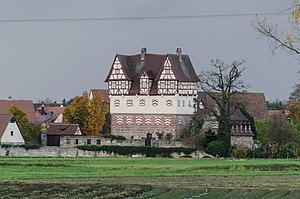Schloss Neunhof: Difference between revisions
imported>Peter Cress (Page created) |
Pat Palmer (talk | contribs) (linking to a photo of the castle from Wikimedia Commons) |
||
| (4 intermediate revisions by one other user not shown) | |||
| Line 1: | Line 1: | ||
{{subpages}} | {{subpages}} | ||
[[File:Neunhof, Schloss-001.jpg|thumb|Schloss Neunhof in 2013.]] | |||
'''Schloss Neunhof''' is a manor house | '''Schloss Neunhof''' is a manor house in Neunhof, a village just north of [[Nuremberg]], [[Germany]]. It is one of the few remaining medieval patrician houses, once numbering nearly one hundred, which is open to the public. | ||
{{TOC|right}} | {{TOC|right}} | ||
| Line 13: | Line 13: | ||
==Description== | ==Description== | ||
The property covers a triangular area of approximately 1.3 hectares (3.2 acres), most of which is occupied by the palace garden on the east side. A nearly-square walled [[bailey]] occupies the southwest corner with a covered bridge across the western moat. The northern face of the wall shows the break where a drawbridge once crossed. The moat, now dry, encloses an area of about 814 square meters (0.2 acres) including the manor house, the stables, and a wash and bath house. The manor house has a footprint of just 13 by 10 meters (33 by 43 feet); the half-timbered upper stories are larger than the ground floor.<ref>https://schloss-neunhof.de/m1_1_schloss_rundgang.html</ref> | |||
The moat, now dry, encloses an area of about 814 square meters (0.2 acres) including the manor house, the stables, and a wash and bath house. The manor house has a footprint of just 13 by 10 meters (33 by 43 feet); the half-timbered upper stories are larger than the ground floor. | |||
==Footnotes== | ==Footnotes== | ||
Latest revision as of 08:03, 25 March 2022
Schloss Neunhof is a manor house in Neunhof, a village just north of Nuremberg, Germany. It is one of the few remaining medieval patrician houses, once numbering nearly one hundred, which is open to the public.
History
The house was originally built in the 12th century, and has been destroyed and rebuilt several times. In the mid fourteenth century the Kreß family, who owned the neighboring Kressenstein manor in Kraftshof, took ownership of Neunhof. The current building was built about 1479 by Hans Kreß, who provided a moat around the house.
Three years after Hans Kreß died in 1500, his childless widow sold the property to a wealthy Nuremberg merchant, Georg Fütterer. Fütterer added a wall and two floors to the house, as well as its characteristic twin gables. Over the next century, the property was sold several times, eventually to the Koler family, patricians to Nuremberg. When Susanna Koler married Johann Wilhelm Kreß von Kressenstein in 1615, the property returned to the Kreß family. Their descendants now own the property, but the last male Kreß descendant died in 1856 and the house was unoccupied for several decades.[1]
In 1961, the German National Museum began restoring the property according to a 1740 floor plan, and in the late 1970's a palace garden was added. The property is now a branch of the German National Museum. It was closed to the public in 2013 for extensive restoration.[2]
Description
The property covers a triangular area of approximately 1.3 hectares (3.2 acres), most of which is occupied by the palace garden on the east side. A nearly-square walled bailey occupies the southwest corner with a covered bridge across the western moat. The northern face of the wall shows the break where a drawbridge once crossed. The moat, now dry, encloses an area of about 814 square meters (0.2 acres) including the manor house, the stables, and a wash and bath house. The manor house has a footprint of just 13 by 10 meters (33 by 43 feet); the half-timbered upper stories are larger than the ground floor.[3]
Footnotes
